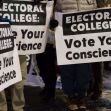The Electoral College was established by the Founding Fathers during the Constitutional Convention in 1787. There were some who thought that Congress should elect the President. Others thought that it should be left up to a popular vote. The Electoral College was a compromise. The Electoral College is a group of people equal to the number of people in Congress. This group comes together every four years to elect the President. The first person to reach 270 out of 538 votes wins the election.
At the time of the convention, no country had elected its leader through a popular vote of the people, so this was a completely new concept. There was one group of people that did not want Congress picking the President because it could cause corruption between the Executive and Legislative branches of government. The other group thought that the general public would not be informed enough to elect the President of the United States. So, the compromise was that each state would appoint electors separate from Congress who would pick the President.
Some benefits of the Electoral College are there that there will be no run-offs or recounts after the election. Columnist George Will talks about what would have happened in the 1960 election if there was no Electoral College: “John F. Kennedy’s popular vote margin over Richard M. Nixon was just 118,574. If all 68,838,219 popular votes had been poured into a single national bucket, there would have been powerful incentives to challenge the results in many of the nation’s 170,000 precincts.”
The Electoral College keeps campaign costs down. Presidential candidates do not usually campaign in states where they are most likely to receive support. For example, Democratic candidates will not campaign in more liberal states like California, and Republican candidates will not campaign in more conservative states like Texas. If we had no Electoral College, campaign costs would be more expensive than they already are. However, this means that candidates focus on campaigning in swing states and are not as likely to go to those states where they know they are most likely to receive support.
A disadvantage of the Electoral College is that individuals feel like their vote does not matter. For example, a Democrat’s vote in a liberal state like California is not going to have as much impact on the results of the election as that same vote in a swing state like Florida.
Getting rid of the Electoral College would be difficult since it would require the passing of a Constitutional Amendment. The process for passing a Constitutional Amendment is a difficult one, as shown by the fact that there have only been 27 amendments made throughout America’s history. There are some plans to reform the Electoral College instead of getting rid of it. There is the National Popular Vote plan where the person who won the popular vote would also receive enough electoral votes to win the presidency. There is also a plan where electoral votes could be split in the states according to the popular vote instead of a winner-take-all system. This would put less emphasis on swing states and provide a more accurate representation of voters. Splitting the votes in each state by popular vote would make more people feel like their vote counted.
Many people feel that the upcoming election is the most significant election to occur in their lifetimes. How this election goes and how the results are received may either calm or excite the push to change the way we choose the president of the United States. We’ll find out soon enough.






